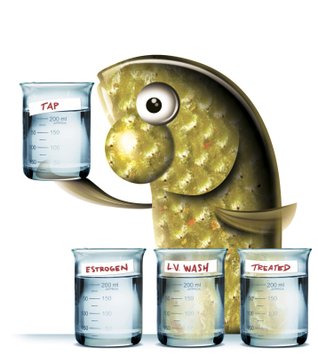Pesticide suspected in mysterious Oregon geese deaths
KTVZ - www.ktvz.com (Source: Associated Press)
19 Apr 2008
Photo courtesy of Oregon Department of Fish and Wildlife
Area: Oregon United States -- Map It
A pesticide is suspected in the mysterious deaths of dozens of federally protected geese this month at a lake near Salem. State and federal wildlife investigators hope to find out by this week exactly what killed about 60 geese at Staats Lake. They're surveying farms in the area for potential off-label use of zinc phosphide, a pesticide widely used to control rodents called voles in grass seed fields. But the geese could also have died from aspergillosis (ah-SPUR-gill-OH-sis), a respiratory disease contracted from eating moldy grain.
 FMD claims rare seladang
FMD claims rare seladangStar Online - thestar.com.my
18 Apr 2008
Photo courtesy of Wikipedia
Area: Pahang Malaysia -- Map It

One seladang (Malaysian gaur) at the wildlife conservation centre in South Jenderak, Pahang, died of foot-and-mouth disease last month. National Resources and Environment Minister Datuk Douglas Unggah Embas confirmed that five seladang at the centre were also infected with the disease. However, he said the disease only affected the seladang at the Jenderak conservation centre. “The area has been cordoned off,” he said. The rest of the 31 seladang have been vaccinated.
 WDIN Highlights Bulletin - Chronic Wasting Disease (CWD) Literature References
WDIN Highlights Bulletin - Chronic Wasting Disease (CWD) Literature ReferencesNBII - Wildlife Disease Information Node - wildlifedisease.nbii.gov
Issue Date: 15 Apr 2008
Volume 03, Issue 04
The Chronic Wasting Disease (CWD) Literature References is the result of a collaborative effort between the USGS National Wildlife Health Center (NWHC), the NBII - Wildlife Disease Information Node (WDIN), and the Chronic Wasting Disease Alliance. NWHC began developing the collection in 2003. WDIN further developed it by indexing the individual articles and making this extensive collection searchable. In 2007, WDIN and the Chronic Wasting Disease Alliance combined resources to expand this collection, titled the “CWD Literature References”. Here's a quick overview on how to search the bibliography for quick and easy access to CWD articles . . .
 This fish story is true
This fish story is trueLas Vegas Sun - www.lasvegassun.com
21 Apr 2008
Photo courtesy of C Morris
Area: Nevada United States
The fish in Las Vegas Bay look healthy on the outside, but it’s what’s inside that matters. For more than a decade scientists have found that some fish in the bay and in the Las Vegas Wash, where treated wastewater is released back into Lake Mead, have mutated reproductive systems and different hormone levels than fish in other parts of the lake. Now scientists are trying to determine whether those differences are the result of long-term exposure to releases of hundreds of millions of gallons each week of wastewater that contains trace amounts of hormones such as estrogen, as well as other chemicals and pharmaceuticals. Local water and wastewater managers are teaming up with federal agencies on a $1 million, two-year experiment that will test the effects of different kinds of wastewater on the reproductive systems of fathead minnows.
Starting this summer, scientists will raise generations of the minnows, stand-ins for the endangered razorback sucker and other native fish, in tanks at Clark County’s wastewater treatment plant on Flamingo Road. They’ll expose the little bait fish to the effluent that runs down the Las Vegas Wash into Lake Mead every day. The goal is to see whether the wastewater — as opposed to ground water contaminated by local industry, chemicals in runoff, temperature differences or other factors — causes changes in the fish. “When we look at the health of fish in the lake, you never know exactly what caused them (the changes) because they occurred over so many years,” said Lynn Orphan, regional water quality manager for the Clean Water Coalition, one of the participating agencies.
 Bats Plagued by Mysterious 'White-Nose' Disease
Bats Plagued by Mysterious 'White-Nose' DiseaseNPR (Talk of the Nation) - www.npr.org
18 Apr 2008
Area: United States
Wildlife experts are trying to determine what's causing hibernating bats in the Northeast to die en masse. The condition has been dubbed "white-nose syndrome," after a white fungus seen on bats' noses — but scientists aren't sure if the fungus is causing the deaths, or is just a symptom indicating the presence of some other disease. So far, white-nose syndrome has been identified in bat caves in New York, southwest Vermont, northwest Connecticut and western Massachusetts.
OTHER WILDLIFE HEALTH RELATED NEWS
Photo courtesy of Wildlife Conservation Society
 Massive wind energy plan refused
Massive wind energy plan refused- Captive tigers 'may save species'
- Sperm "on the rocks" - Using semen cryopreservation to protect amphibian species
- Editorial: Science is clear -- baiting and feeding deer must stop
- World's Rarest Gorilla Finds Sanctuary
- FUW welcomes support for TB eradication programme
- Montana wants prairie dogs from Wyoming
- Pinal officials warn of high rabies incidents -- Map It

- Fourth case of rabies reported in Salem County in 2008 -- Map It

- 17 Dead from Rift Valley Fever Outbreak
WILDLIFE HEALTH RELATED PUBLICATIONS
Predicting natural mortality rates of plants and animals
Ecology Letters. 2008; [ahead of print] [online abstract only]
MW McCoy et al.





No comments:
Post a Comment